
The eleventh monthly report monitoring the activities of al-Qaeda and Islamic State branches throughout the Sahel will focus on the propaganda output of these groups in October 2023. This October, the propaganda outlets linked to these terror groups published the highest number of claims since the Counter Extremism Project (CEP) began monitoring them in December 2022. During October, 87 incidents in total have been claimed by the Islamic State’s affiliates ISGS and ISWAP and by az-Zallaqa Media, which publishes all claims by al-Qaeda’s branch JNIM. This steep increase of claims came unexpectedly, especially as the number of incidents claimed by these groups had remained stable in the previous months. With this sudden surge, October constitutes the deadliest month in the wider region since CEP started monitoring.
Attacks claimed by JNIM in the region (especially in Mali) have almost doubled in the last month. With an all-time high of 49 incidents, JNIM claimed more attacks in October than ISWAP and ISGS combined. Claims by ISWAP remained at their monthly average of about 20 attacks. ISGS, which in September had been strategically silent as far as claims for attacks were concerned, returned to its normal rate of about 15 claimed incidents per month.
As outlined in previous reports, there is strong reason to believe that all three terror groups in the region are underreporting on their activities. Even with the significant number of claimed attacks in October, JNIM is likely still not publishing every single operation they carry out. The reason for the sudden surge in JNIM propaganda output is unclear, but it is likely that that the general call for Jihad in Mali, published on August 21 by the JNIM-linked propaganda outlet az-Zallaqa Media, is one of the causes. Another element that likely caused this surge is that the overall security situation in Mali continues to deteriorate, leaving ISGS and JNIM fighting for control against the Malian army, the Wagner Group, and each other.
Attacks in the Sahel: General Trend
During October 2023, there was a dramatic increase of claimed incidents, especially in Mali, where JNIM seems to be the most active terrorist group. In total JNIM claimed no less than 49 attacks, the overall majority (31) in Mali. The rest of the attacks in Mali (8) were claimed by the Islamic State’s Sahel Province (ISGS). Also, in Burkina Faso the Islamic State and al-Qaeda are steadily gaining more control of swaths of territory as they gradually increase their operations. October thus also witnessed the highest number of attacks in Burkina Faso (17) since CEP started monitoring.
Another notable event took place late September when ISGS claimed two attacks on JNIM in Burkina Faso. It raises questions as to whether there really was a cease fire between JNIM and ISGS. At this point it is unclear, but in Mali at least both terrorist groups did not clash directly with each other. The main targets for both groups remain the Malian armed forces and the Wagner Group. In fact, the number of claimed attacks on the Wagner Group is continuously increasing.
Beyond Mali and Burkina Faso, the number of operations publicly claimed by ISWAP remained more or less on the same level throughout all previous months. In October, ISWAP-linked propaganda outlet an-Naba’ reported 22 attacks by ISWAP in Nigeria. As before, all attacks are of relatively low impact, with only small numbers of Nigerian soldiers or militia-members being ambushed and killed. ISWAP rarely engages in large scale operations against the Nigerian army, and last month’s statistics again confirm this.
Since the coup in July, Niger is a preferred new battleground for both JNIM and ISGS. At least eight different incidents were claimed by these groups in Niger. Only two claims were posted by the JNIM linked-propaganda outlet az-Zallaqa Media. ISGS however was very active. In addition to incidents that occurred in October, its propaganda outlets also reported incidents that occurred in August and September. Therefore, ISGS has broken the strategic silence that it had maintained throughout September.
Table 1: Claimed Attacks (December 2022 – October 2023)
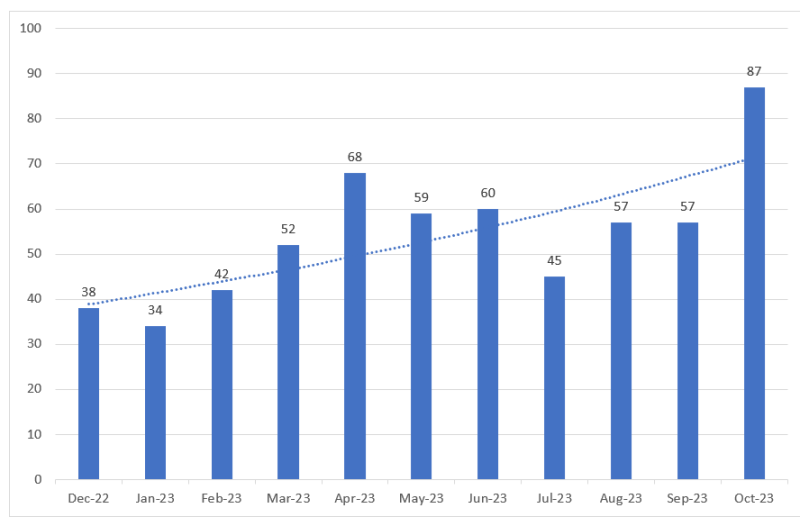
Table 2: Claimed Attacks per Group (December 2022-2023)
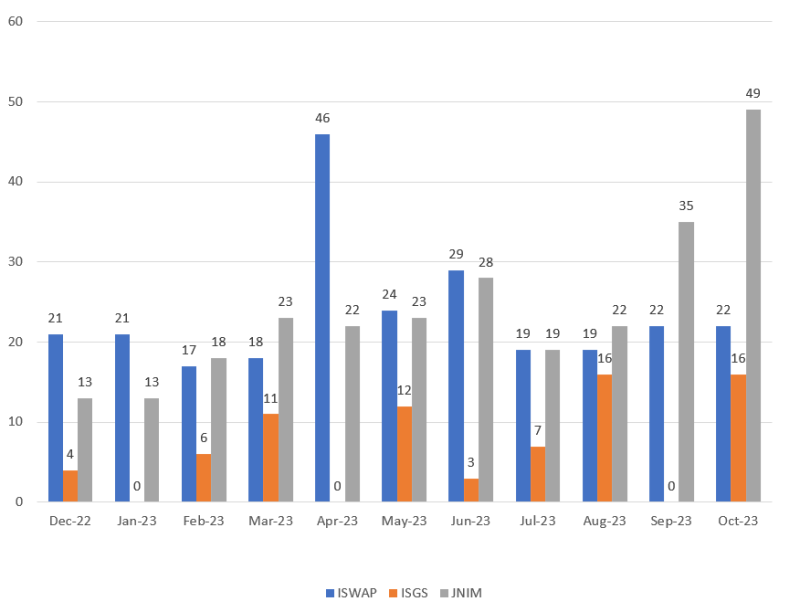
Table 3: Claimed Attacks per Country (December 2022 – October 2023)
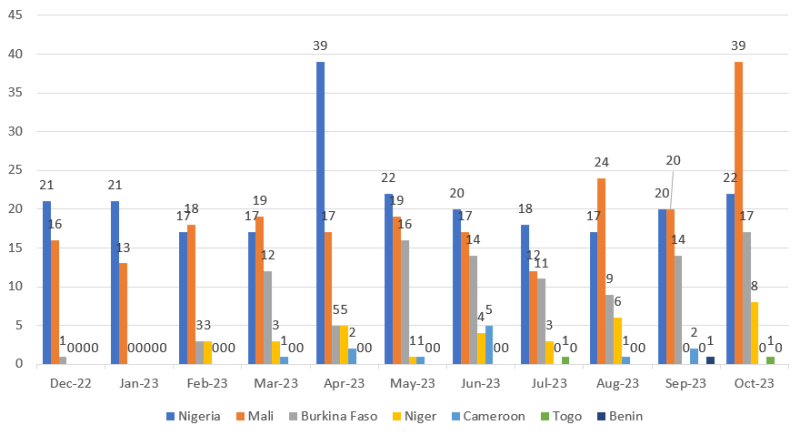
Attacks per Country
As pointed out above, October saw the highest number of attacks since CEP began monitoring in December 2022. There were more attacks claimed than during the entire month of Ramadan, which is traditionally seen as a “month of Jihad” and usually sees a spike in terrorist activities. Out of the 87 registered claims, more than half were claimed by JNIM (49). This high number of claimed attacks by JNIM contributed to the significant increase in the overall number of claimed attacks per country. This was particularly the case in the countries in which JNIM operates: Mali witnessed a total of 39 claims, followed by Nigeria (22), Burkina Faso (17), Niger (8) and Togo (1).
Map 1: Estimates of the frequency and deadliness of reported incidents involving jihadist groups (January 2017 – October 2023)
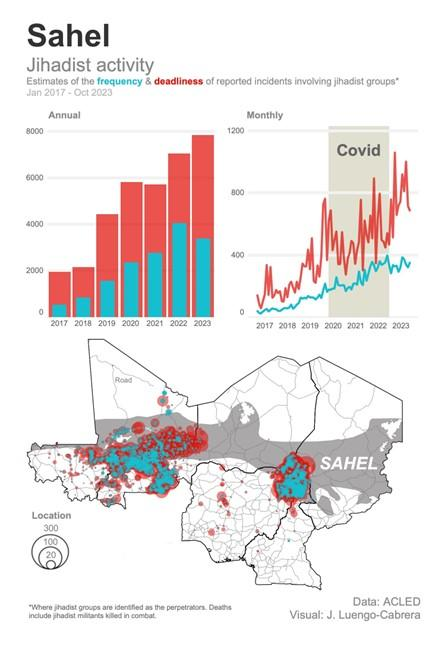
Source: https://x.com/J_LuengoCabrera/status/1724760055277391928?s=20
MaliDuring the last few months of reporting, the quickly deteriorating security situation in Mali became obvious, even though CEP reporting only concentrates on terrorist incidents that are claimed by propaganda-outlets linked to JNIM, ISWAP and ISGS. This trend continued in October. The number of claimed terrorist attacks and their targets demonstrates the growing security vaccum that the end of Western military operations and the continuing withdrawal of UN forces create in the country. No less than 39 attacks were claimed, the majority (31) by JNIM-linked propaganda outlet az-Zallaqa Media, with 8 attacks claimed by ISGS in Mali. Furthermore the Touareg rebel movement of Azawad (CMA) is taking advantage of the local insecurity, temporarily taking control of the base of Kidal after it had been vacated by the United Nations Multidimensional Integrated Stabilization Mission in Mali (MINUSMA) as part of their overall withdrawal from the country. Consequently, at one point the Malian army was fighting on several fronts at once in October.
Most notably, ISGS seemed to be focusing most of its attacks in October on the Touareg Azawad Militia (CMA). On one occasion ISGS also reported the implementation of Hadd al-Hiraba, one of the Islamic Penal Laws (Hudud). The enforcement of this Hadd usually means the amputation of the right hand and the left foot, sometimes followed by crucifixion. This demonstrates once more that wherever the Islamic State gets control over a local population, it immediately applies Shari’a in all its aspects and in its most brutal form on the local population.
Still, al-Qaeda was the most significant factor of insecurity in Mali in October 2023. No less than 31 incidents were claimed by az-Zallaqa Media. In 26 operations the Malian army was the main target, and in 16 of these claimed incidents the Wagner Group was involved. This either points to the fact that more Wagner troops are deployed by the Malian regime, or that JNIM is more actively looking for Wagner troops to attack. The first scenario is more likely: when the locations of JNIM attacks are plotted, no obvious geographical pattern emerges, pointing to the fact that Wagner forces are more dispersed in the country than before.
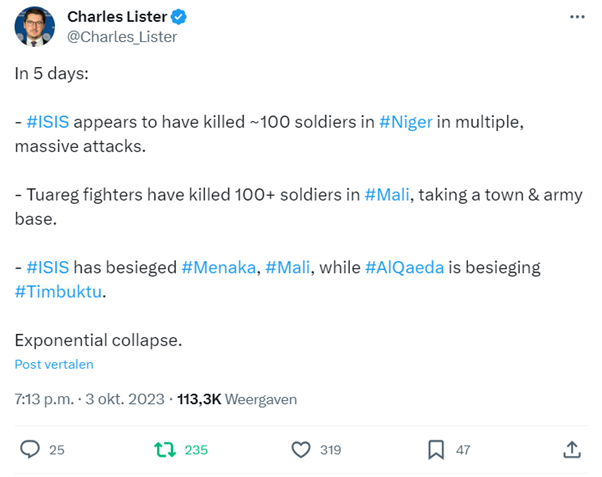
Unfortunately, the attacks that have been claimed only seem to be a part of the overall story. Gao, the largest city in northern Mali has been blockaded by JNIM, while some 320 km west the group has has been trying to completely cut off the historic city of Timbuktu in the north of the country, preventing supplies reaching the city. The blockade of the two cities comes as competing forces in Mali scramble to fill the security vacuum caused by the departure of international troops.
Furthermore, all recent security incidents have challenged UN troops attempting to organise an orderly retreat of their material. The situation is so tense that in some cases UN forces were forced to destroy their material to prevent it from falling into the hands of terrorist forces or Touareg rebel forces.
NigeriaNigeria witnessed 22 attacks. This number is within the average range of attacks claimed by ISAWP during past months. All attacks were claimed by ISWAP. Again, as usual, the trend of relatively low impact attacks with a low number of casualties continues. The highest number of claimed casualties was an attack on October 20th near Borno, when ISWAP claimed ten casualties. As in previous months, the key areas of operation of ISWAP remained the Borno and Yobe provinces. As before, sporadic attacks on Christian villages were reported.
Burkina FasoA total of 17 incidents have been claimed in Burkina Faso. 15 claims were posted by the JNIM-linked propaganda outlet az-Zallaqa Media and two by an-Naba’ on behalf of ISGS. JNIM focused all of its attacks on the Burkinabe army and supporting militias. ISGS started attacking JNIM again. It is currently unclear whether the supposed cease-fire between JNIM and ISGS still stands and / or whether this truce was only applicable to the territory of Mali. Nevertheless, these incidents clearly demonstrate that despite any potential agreements, ISGS and JNIM still see each other as enemies in their fight for supremacy of terrorist operations within the region. Therefore, infighting between terrorist groups will remain a feature of the overall security situation in the Sahel.
NigerSince the late July coup in Niger, the security situation in the country has been declining steadily. After ISGS’s strategic silence in September, the group’s propaganda outlets have resumed reporting, and in addition to attacks conducted in October, included attacks as far back as August 20th in their reports. All of these claims seem to correspond, more or less, with official media coverage at the time.

TogoOne single attack was claimed by az-Zallaqa Media, killing four soldiers of the Togolese army.
Table 4: Total Number of Attacks
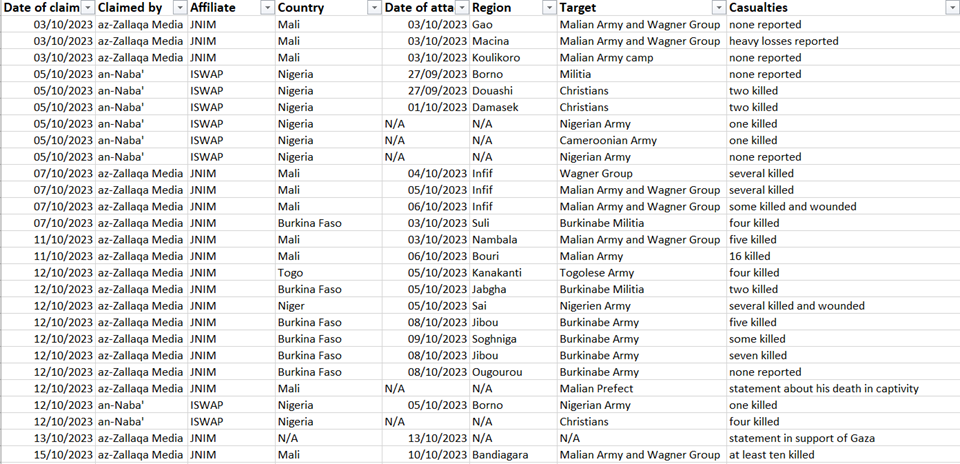
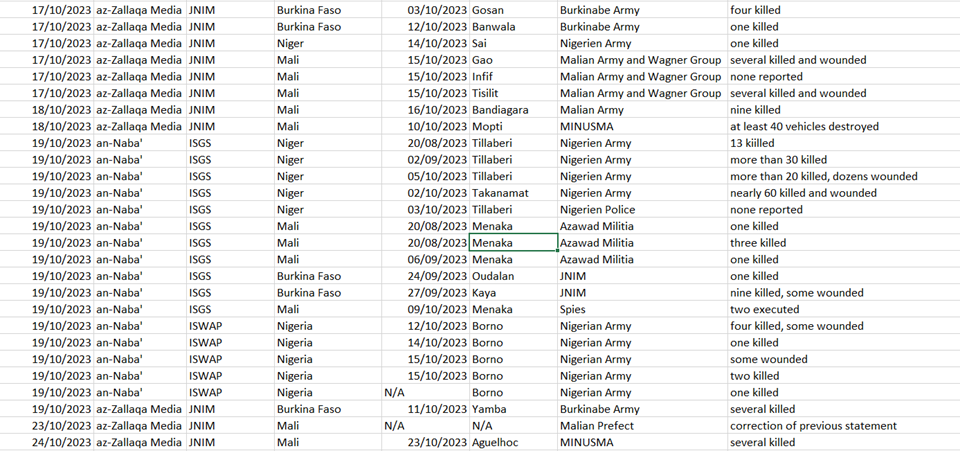
Attacks per Affiliate
JNIM
No less than 49 claims were published last month by az-Zallaqa Media, reporting on the activities of al-Qaeda’s branch JNIM. The Malian army and the Wagner Group were the main targets and its seems that JNIM is increasingly focusing on these in Mali in addition to withdrawing MINUSMA troops. On at least four occasions az-Zallaqa claimed attacks on UN convoys passing through Mali. Another target was the Burkinabe army and militia.
Table 5: Attacks by JNIM
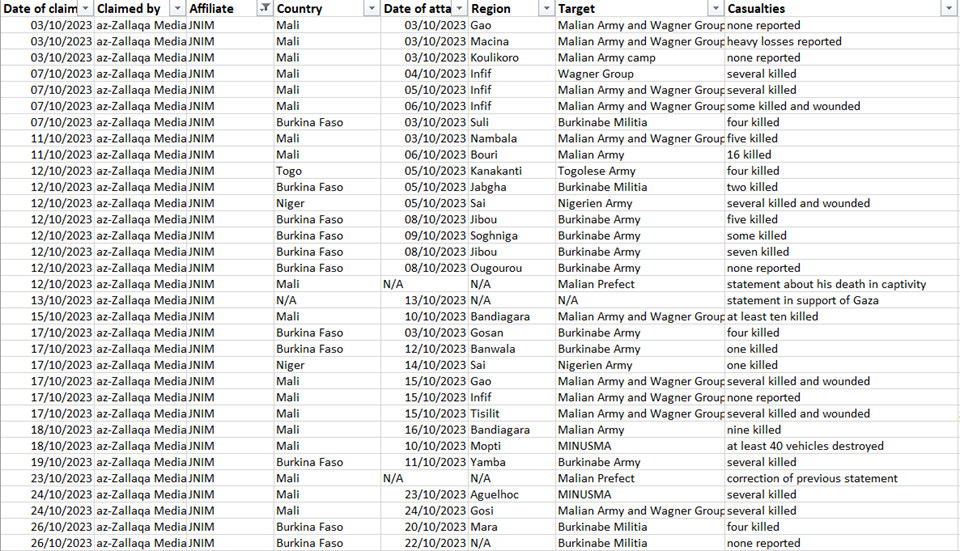

ISGS
A total of 16 incidents were reported by an-Naba’ on behalf of ISGS. The majority of the attacks took place in Mali but the most impactful attacks, with a high casualty rate, were conducted in the neighbouring country of Niger. The ISGS-linked propaganda outlets claimed that more than 120 Nigerien soldiers were killed or wounded in October 2023.
Table 6: Attacks by ISGS

ISWAP
Twenty-two attacks were claimed by ISWAP, all of them in Nigeria. Most attacks targeted the Nigerian army. However, the group also continued attacks on Christian villages. The number of these attacks are slowly increasing. All claimed attacks had a relatively low impact yet of course contributed to the further destabilization of the overall security situation in the Lake Chad Area.
Table 7: Attacks by ISWAP
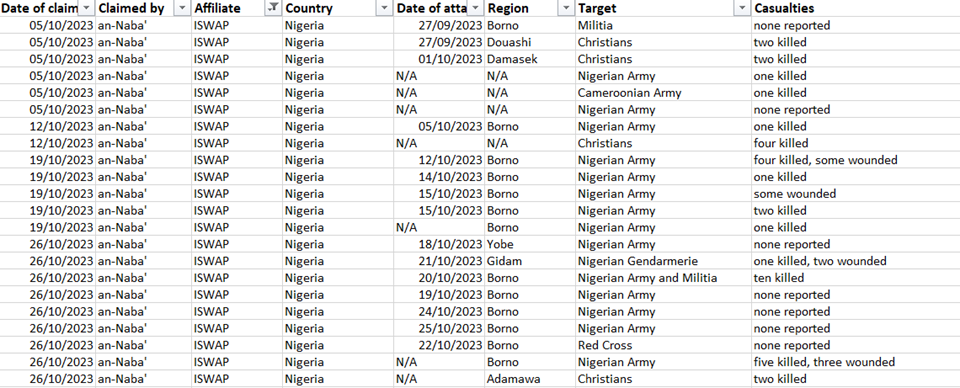
Conclusion
Since CEP reporting began in December 2022, the deteriorating security situation has been outlined in each monthly report. Unfortunately, October 2023 witnessed another stage in this process, with a record number of terrorist attacks claimed by the propaganda outlets linked to JNIM, ISGS and ISWAP. As the propaganda outlets of all three groups systematically underreport terrorist operations in the region, the fact that even this partial picture is pointing to a new low in the overall security situation is concerning. This is coupled with the decreasing ability of Western and UN forces to counteract extremist violence, as they have withdrawn or are in the process of withdrawing from several countries in the region. This also creates obvious challenges that national security forces in the region face. Furthermore, it is also clear that Wagner forces operating in the region are not an effective replacement for internationally-supported counter terrorism operations. In fact it seems that Wagner forces only enrich the target environment for terrorist groups. Therefore, it is not currently possible to see a scenario in which the security situation is stabilized. The continuous spread of terrorist violence and influence within the Sahel region is the most likely outcome going forward.
